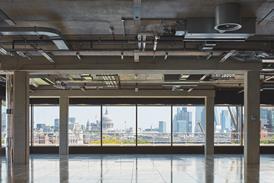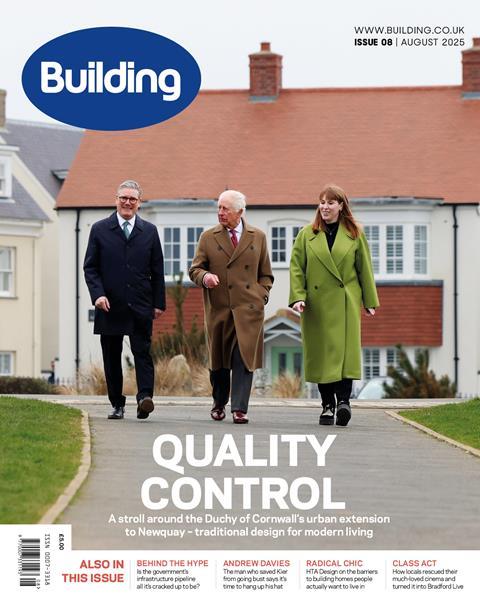Amid the economic doom and gloom, some commentators believe confidence is returning, just slowly. So what will give it a boost?

Construction folk tend to be plain speaking, and if you ask them about the state of the market – as the Building team frequently does – they tell you straight. “Grim” is how one boss described conditions, and this pessimism seems to be backed up by the latest sentiment data coming from the Purchasing Managers Index (PMI) for construction last week.
With any score under 50 representing no growth, it was clear that the latest slump to 44.3 – the sharpest fall since the height of the pandemic in May 2020 – was not good news. The survey showed all sub-sectors contracting and companies buying fewer materials and reducing headcount.
The same week we ran trading stories from builders merchant Travis Perkins and the product manufacturer SIG pointing to continued weak demand, and suggesting the timing of any recovery is uncertain.
It is easy to identify some of the key blockers in the way of economic growth at the moment. High up on the list are funding and regulatory bottlenecks that are slowing down projects. I’m talking about continued delays caused by the planning system and the plummeting residential starts held up by the Building Safety Act approvals process. Increasingly, developers are relying on bridging loans because funding is so delayed, and this has a trickle down effect all the way through the supply chain.
What the government does next could either boost or shatter any emerging signs of confidence
The growth many UK businesses hoped for in 2025 in the wake of a new government with fresh plans – many of which rely on construction’s contribution – has not materialised. Yet.
And the word “yet” is worth lingering on because as dire as the PMI data looks, there are many commentators and companies out there who think they can see signs of improvement in the medium to long term.
Products firm Marshalls in its interim results is perhaps an example. Although it has downgraded its 2025 forecast, looking further forward it says it is encouraged by the government’s housing and infrastructure investment. Even the PMI notes that commercial construction decline is softening.
Last week we also reported on the latest findings from the RICS UK Construction Monitor update, which showed workloads are flat but stabilising, with infrastructure the star performer. More than that, 17% of respondents expect higher workloads over the next year, showing that there are pockets of confidence.
Several economists have pointed to emerging tailwinds including easing inflation which has stabilised costs for core materials. And last week’s cut to interest rates should gradually improve financing conditions, especially combined with low vacancy rates in prime offices and residential which should support rental growth.
>> Also read: Slowly does it: where is this elusive growth for construction?
>> Pipe dreams: Why the infrastructure pipeline must improve if construction is to benefit
Another positive sign is that increased commercial lending suggests developers are preparing to start more projects. It would seem that the London commercial property is attracting some new investment, with UK assets seen as cheap internationally and the country enjoying political stability compared with other markets. It has been heartening to see jobs being awarded to firms on a few major London schemes such as the £400m 60 Gracechurch Street tower and the £700m British Library redevelopment. Equally welcome is evidence from firms such as Morgan Sindall that the London fit-out market is booming.
More widely, companies are also set to benefit in the longer term from some strategic investment drivers. Over the summer we have had the government announcement of the £530bn infrastructure pipeline, with details of some 780 projects. Official reaction to the pipeline has been mostly positive with many welcoming clearer plans that should boost industry confidence.
That is not to say the pipeline is perfect, far from it, but it is a start and something industry leaders hope will improve if ministers and civil servants listen to some very practical suggestions from industry (highlighted in our analysis of the pipeline).
As an aside, one construction boss recently confided that despite the pipeline announcement, they do not have confidence it will lead to shovels in the ground soon. Without seeing where the money is going to come from, firms come to doubt that everything promised will happen. That leaves them spending a lot of time figuring out which projects to place their bets on. So, one practical bit of help from government would be to promise fewer projects but with more funding certainty. Any takers?
Back to positive economic indicators, here is a final one from the jobs survey by KPMG and REC UK. While it is clearly concerning that demand for workers in the British economy cooled in July, there was a rise in temporary vacancies in construction, which is seen as an early sign of returning confidence. Meanwhile, though, engineering was the only job sector that showed higher demand for permanent staff.
That said, employers in the built environment – just like the rest of the economy – blame the chancellor’s National Insurance Contribution increase for stalling this year’s recovery. And they are fearful of extra burdens that could be imposed by the Employment Rights Bill as well as the potential for more tax-raising measures in the autumn Budget.
This is a pivotal moment: what the government does next could either boost or shatter any emerging signs of confidence in the market. Critical issues undermining that confidence – regulatory delays to projects, forthcoming employment legislation and plans for the next Budget – can only be resolved in partnership with the private sector. The government must change tack: stop treating construction firms as a problem, start working with them on solutions.
Chloë McCulloch is the editor of Building




























No comments yet